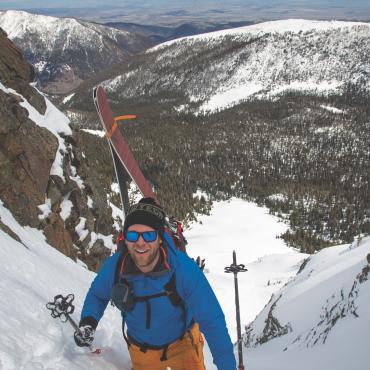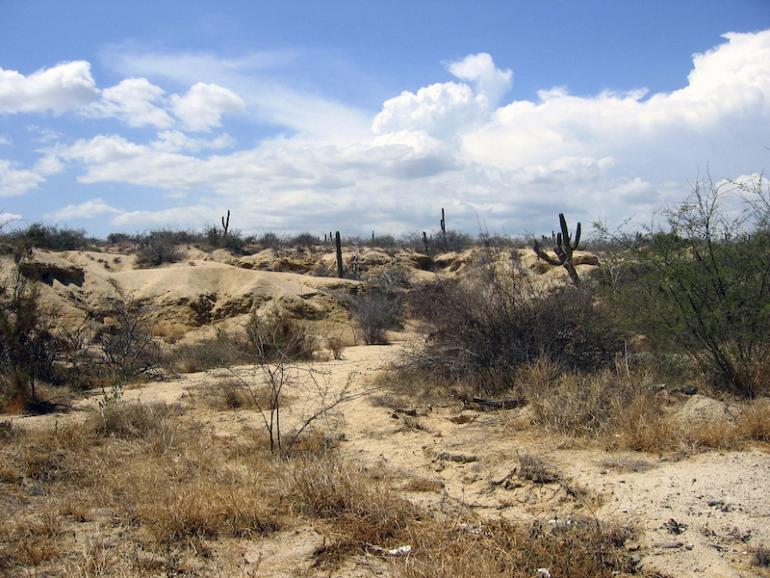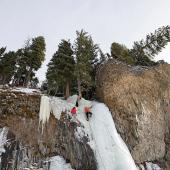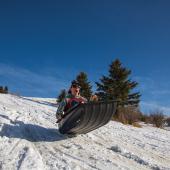Baja 500
Motorcycle race in Baja, Mexico.
The desert stretches for as far as you can see. Though it’s only June, the heat is brutal and exhausting. Silty dust hangs in the air, a reminder of the racers still in front of you. You shift down through a low, dust-choked wash and without warning you’re airborne at 50 miles per hour. You level the motorcycle and land smoothly for the hundredth time today. Beneath you, the 650cc engine barks, the tires catch, and you accelerate once again into the sun.
The Baja Peninsula in Mexico, where the annual Baja 500 desert off-road race takes place, is a long way from Montana. Last spring, two local riders rolled the dice and entered the race fueled by the dream of finishing one of the most difficult desert races in the world. Jamie Cabish and Reid Erickson were first inspired to enter after watching Dust To Glory, a film chronicling the legendary race. They knew that fewer than half of those who enter the race finish—but for these self-proclaimed motorheads, it wasn’t about winning or losing. They wanted to test themselves in the raw landscape of the Mexican desert and have the adventure of a lifetime.
Cabish, a Big Sky banker, first watched Dust to Glory in November of 2005. Fewer than eight months later, he and Erickson, a Livingston architect, were running the race themselves. Cabish’s wife is the one who first suggested it. “She said, ‘Why don’t you just do it?’” says Cabish, “I hadn’t thought seriously about it before.”
With elevation changes of 5,000-6,000 feet, course surfaces ranging from paved highways to bottomless silt beds, and over 400 competitors on the course, the 500-mile race is a unique experience. “The landscape was just amazing,” says Erickson, “we’d come over a hill and be floored by the views.” But that same beautiful and unique landscape made travel extremely difficult. Tricky mountain trails with precipitous drop offs, sections of sand moguls, sharp rocks, and jumps kept the racers on their toes. Cabish says, simply, “It was an adventure.”
In the beginning, they had no motorcycle, no support team, no real plan, and nobody spoke any Spanish. “It was ridiculous,” says Cabish. To help cut costs and ensure they had a decent bike for the race, the pair split the cost of a new motorcycle—a Honda XR650R. They modified the brand-new bike with a custom-tuned suspension, steering stabilizer, larger fuel tank, and other race-specific parts before heading to the desert.
Planning for the race was difficult. Erickson says, “The whole thing was a logistical problem more than anything. We didn’t know what we were doing.” It’s a huge event, spread over a long distance. The race attracts over 400 entries from all over the world. Motorcycles, ATVs, buggies, and trucks all run on the same course, and getting fuel, parts, and service to racers requires a support crew. For the Montana duo, it was a family affair, with relatives from as far away as Minnesota coming to help out. With a bike, a ragtag crew of siblings and in-laws, an enclosed trailer, and a spare set of wheels and tires, the racers and their entourage struck out for Mexico in May of 2006.
“We’d tell people what we were doing and they all thought we were crazy,” says Cabish. Most teams have four riders, with each riding a single leg of the race. Cabish and Erickson split the mileage only two ways. But that’s the way they wanted it. “We wanted to go down and ride it,” says Cabish, “Leave it all out there, hope we finish, and have a great time.” The race is a physical test, with most of the course running over the uneven, sandy desert surface, with few places to rest. And the race was not without its technical problems.
Cabish caught a sharp rock at mile 40 of the first leg, and a flat rear tire nearly ended the race for the team. Luckily, locals came to the rescue with a spare tube and “with two guys holding up the back of the bike, we managed to change the tire with a Phillips screwdriver and a crescent wrench.” says Cabish. He later flattened the front tire on the same leg but limped into the pits to hand the bike off to Erickson. After a double wheel and tire change, the team was back in business, at least two hours behind schedule.
The next two stages went smoothly, but because of the early delay Erickson was forced to run the last leg of the race in the dark. With light silt hanging in the air like a fog, the motorcycle headlight was useless. “I could only see the edge of the road if I looked straight down with my helmet-mounted light,” says Erickson. Later in the night, he became lost and got stuck on a silty hill. Locals came to the rescue once again. They helped push the bike out and sent Erickson in the right direction. The speeds reached during the race were as high as 110 miles per hour, “as fast as the bike could go,” according to Cabish, but the overall average speed including stops was about 27 miles per hour. The team finished with only about a minute left before the regulation time of 18 hours, after which they would have been disqualified. They had succeeded, but by the end Erickson says, “We were smoked.”
The most difficult part of the race for Cabish was after the rear tire went flat so early into the race. “I was so upset; I thought I was going to let everyone down. I mean, Reid hadn’t even ridden yet and it looked like we were done.” For Erickson, it was repeatedly getting mired in silt. The locals who helped get them back in the race “were just great. I didn’t speak a lick of Spanish, they didn’t speak any English, but they were just really great,” says Cabish.
The local Mexican population turns out in droves for the annual race. “It was like the Superbowl is here,” says Cabish. Erickson adds, “It was crazy; people just littered the course, cheering and having a good time. The people are an absolute highlight.”
The racing community is tight-knit as well. After their trailer was broken into and their tools stolen near the starting line, another race team let the Montanans use their tools to do repairs. “It was a great energy in town,” Cabish says.
The pair is going back to Baja this year to run the race again. To train, they ski (Cabish says riding the long sections of sand-covered whoops is “just like skiing bumps”), trail run, hike with their kids, hit the gym, and of course ride motorcycles as much as they can. “We’re motorcycle families. We take the kids on their 50cc’s and head out to Pipestone on the weekends. It’s what we do.” says Cabish.
Both men look forward to the time when their children can race in Baja, “and we can sit in the truck, drink beer, and tell them what they’re doing wrong.” laughs Cabish.
The goal this year? Erickson grins and answers, “Finish before dark.”










